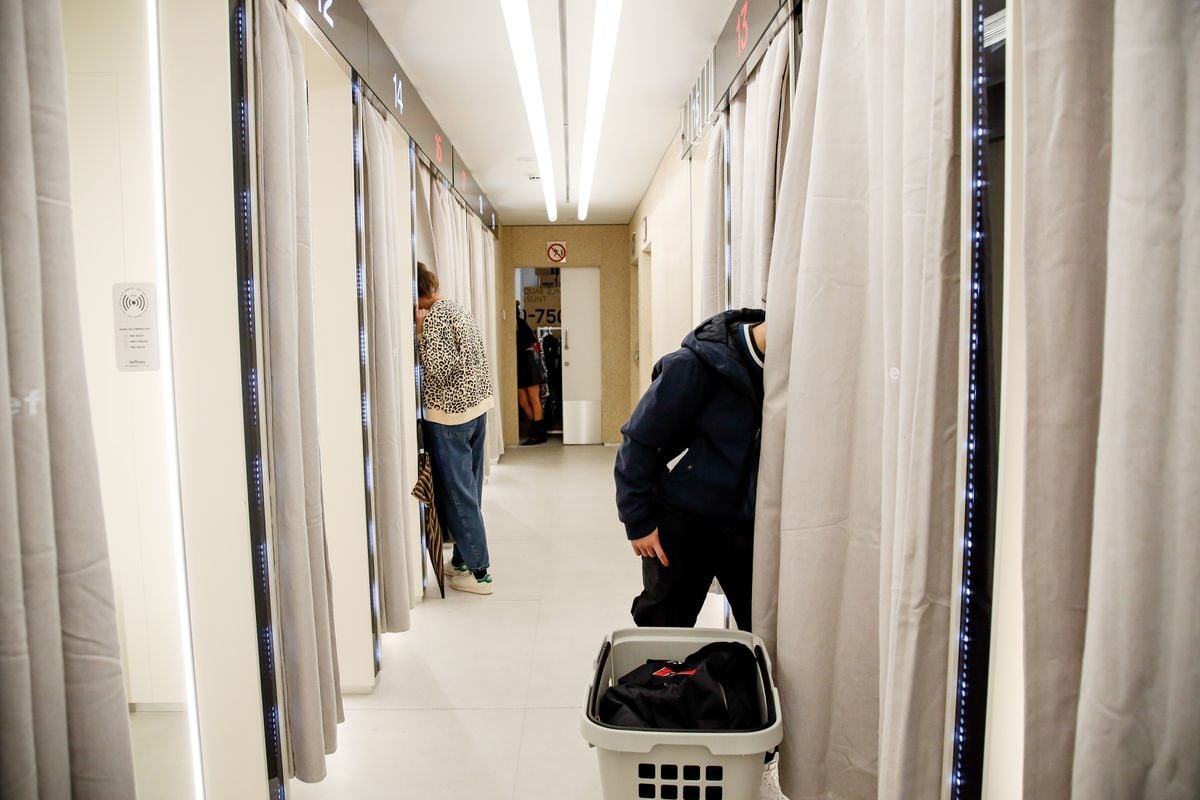Ten girls wait impatiently to enter the changing room of a well-known
fast-fashion store
(fast fashion) in the center of Madrid.
It's half past seven in the afternoon on a spring Saturday, peak time for weekend shopping.
They endure the sweltering heat on their tails and hold various items of clothing slung over their arms.
"I don't know why I'm going in, if I'm sure nothing looks good on me," says one of them.
They sneak their friends into the space of little more than one square meter and ask her mother for advice to make sure that what the mirror tells them is true.
The hangers are stacked on the hooks and there is no room for the bags.
The direct light reveals every detail of the skin, examines how the garment fits down to the last centimeter of her body.
When leaving, most of them deposit in front of the saleswoman all the clothes that they had considered buying, but which, in the end, they have discarded.
Because their size —the usual one— no longer fits them.
Because the XL of the trend top does not cover the chest.
Because if the jean enters at the hip, it is loose on the thigh.
For an endless number of reasons that make the process of going to buy clothes a bad thing for many people, especially women.
The image is repeated in many of the stores in the center of the capital, and the windows of all of them are dominated by almost scrawny mannequins, none of which are large, and colorful designs that bring the fashion of the early 2000s to the streets: jeans and low-waisted skirts, crop tops, tight mini dresses, cargo pants.
Far from the tumult of the shops on the street, on the big catwalks, visibly thin models parade—once again, they already did it in the 1990s.
The aesthetic of extreme thinness returns, the
heroin chic
style , and many celebrities and
influencers
, like Kim Kardashian, once an icon of curves, lose weight.
The revolution of sizes and inclusiveness have not finished settling in practice.
With all this, hundreds of young people denounce that facing the changing room and shopping is increasingly complicated.
"Being in a store, especially a fast fashion one, is already an anxiety-producing process in itself," explains Ester Silva, a psychologist specializing in eating disorders with a gender perspective.
Long lines, constant movement or the fact that the curtain does not close properly and someone can see us from outside are some of the factors that cause stress inside the stores.
“But inside the fitting room, the experience is amplified.
The white lights illuminate every detail of the skin, the mirrors focus parts of our bodies from perspectives that we are not used to seeing.
It is a cult space for exhibition, and this amplification causes a magnifying glass effect in our heads that leads us to a meticulous analysis of our bodies”, continues the psychologist.
This meticulous study is difficult to digest.
It can lead to self-image problems, which Silva defines as an obsession or excessive concern about some part of our physique that, although it is practically imperceptible, takes up a lot of space and time in the mind, and that can generate processes of anxiety, depression and social isolation. .
For Silva, however, the problem begins even before setting foot inside the premises.
“You have to review the function of going to the shops.
On many occasions we go just because we need a momentary gratification, something that makes us feel better.
But these expectations are not easy to meet, which increases the risk that the result will be harmful ”, he develops.
Some women don't even have hope.
“It is totally impossible to find more than a size 44 in a physical store,” says Marta Camín, stylist,
curvy
model and creator of specialized fashion content.
However, many of these stores do have larger sizes on their web pages or shopping apps, and there are brands specialized in plus sizes, although their prices are sometimes higher.
“Others had their
plus size space
, but they closed, such as Violeta By Mango, with the promise of integrating these sizes into the brand's usual line, although that has not happened”, says the stylist.
The sub-brand of the Catalan group closed in 2021. The objective of diversity has not yet been met, neither in this nor in most of the physical stores of the rest of the brands, with the exception of a few such as the giant Primark, which has up to size 48. "It's very good, but it still falls short for many people," laments Camín.
The debate over the absence of sizing or the differences in measurements between brands transcends the individual.
On the terrace of a bar in the Madrid neighborhood of Lavapiés, 25-year-old Mar Gadea talks with several friends about how stressful it is for her to go shopping.
She says that she prefers to buy directly on the website to avoid the bad taste of the fitting room.
“But, then,” she says, visibly indignant, “if all of us here have different bodies and none of us are worth anything, who do they do the carvings for?”
Alba del Campo, a 30-year-old from Bilbao, recognizes herself in the stress of this group of young people: “There are mirrors that are horrible, the image you see is totally distorted.
Sometimes that can make you buy things that don't really fit you, or vice versa.
You come home and you think:
'Where is what I saw in the fitting room?
Does not exist".
On the social network TikTok, all you have to do is search for the words
Zara
and
sizes
to bring up dozens of videos of women in the changing room, in which they show how they don't finish filling out a garment, how the smallest size stays big, or how the largest big does not fit
Inditex sources assure that the multinational is committed to diversity: "We work to offer a wide range of sizes and designs in the articles of our brands."
Zara's denim
line
, for example, offers sizes between 32 and 46. "Our goal is to constantly improve in this regard and, therefore, we pay the greatest attention to the
feedback
we receive from our customers," they say.
One of the possible explanations for the phenomenon is the inclination of the firms to unify the sizing progressively.
“Before, in a store, we had from 32 to 46, normally.
Now, more and more tend to S, M, L and XL.
We have gone from eight sizes to four”, explains Camín.
This creates a ladder effect: “The old 32 is now an S, spanning several numbers, so some people are too big for it.
And the M has to be made small to accommodate those who are not worth the S”.
And so on.
The main reason is the reduction in costs that fast fashion brands obtain by having to design only four patterns instead of, for example, eight, as expressed by Camín.
“Pattern making is the most expensive part of making clothes, not the fabric itself.
And it is much easier to design for a person with less size than with more”,
The general restlessness is not only caused by the changes in the size, the differences between brands or even within the same store.
The influence of social media also plays a key role.
At the end of 2022, an audio of the model Bella Hadid —considered by many young people the new top model—
spread on TikTok
of his era—, which many users used to talk about their restrictive diets and glorify, in a masked way, extreme thinness.
Meanwhile, the famous show off their body, slimmer than before, in Instagram stories.
Silva explains that this creates a mirror effect: “We focus on achieving an individual improvement of a need that has been created for us and that is not real.
Before we were only exposed to what they showed us on TV, to the mannequins.
Now, the repetition of these 'perfect' images makes us obsessed with meeting those standards to which we have exposed ourselves”.
Fashion is a reflection of society, and people are obsessed with being thin
Marta Marín, creator of fashion content, stylist and 'curvy' model
Some stores have announced collections with images of plus size models, but then the clothes do not fit well on different body types.
“And that is not being inclusive.
It's putting it on the cover to look good," says Camín, who points out that in New York Fashion Week this year, of the more than 2,500 models, only 200 were
curvy
.
“Now there are at least 200, but it is still a minutiae.
You have to aspire to have more and more, ”says the content creator.
In practice, however, it is more complicated.
It is not profitable for the industry to increase the size or the
stock
.
And pretty much everything that's seen on the runway ends up in stores, including the idealization of thinness.
“But fashion is a reflection of today's society and a reflection of what is to be.
And people are obsessed with being thin”, points out the stylist.
Among the possible solutions, demand from the big brands a universal sizing chart for all stores or patterns closer to the morphological reality of women, something that the Generalitat of Catalonia has proposed, and for which the regional law on consumption.
Camín explains that it is difficult to combine criteria in pattern making.
First comes the manufacturing, then the metric differences between the youngest and oldest people.
And “the target audience”, says Camín, who “prefers the illusion of seeing themselves thin to assuming that they are wearing a larger size”.
“We are not going to get a brand to make sizes for everyone, they are not going to shell out that money.
What can be done is to make people aware that there is nothing wrong with wearing a 44. That being fat is not bad, being skinny is not bad, being normal is not bad, ”he continues.
The stylist also stresses the importance of asking for specific stores, just like there are for shoe sizes.
“The problem is that we have it stigmatized.
You have to feel proud of going to a plus-size store, because it's just that, one size”, she concludes.
The fitting room design is already changing in some stores, which have assimilated the importance of improving the customer experience.
They begin to install adjustable lighting and mobile mirrors, adjustable to taste.
“They are humanizing the process.
The clerk introduces herself, asks for your name to write it down.
Before it was colder, it crashed more”, recalls Del Campo.
There is still how to deal with leaving the store, sometimes without a purchase.
Silva recommends being careful with exposure, and avoiding it at all costs if fashion affects us psychologically.
“We have to introspect, know what moment we are in and if it is convenient to go to these places of exposure, such as fitting rooms or social networks”, he develops.
Del Campo, who studied personal and corporate image consulting, also advocates responsible use of social networks: "You have to do to see diverse content, consciously and actively search for, for example, plus-size models that we like , because if we only consume videos or photos of very thin people, that is all that the algorithm shows us”.
And, of course, detach the body from the purely aesthetic, understand that it fulfills many other, more important functions.
Subscribe to continue reading
Read without limits
Keep reading
I'm already a subscriber














